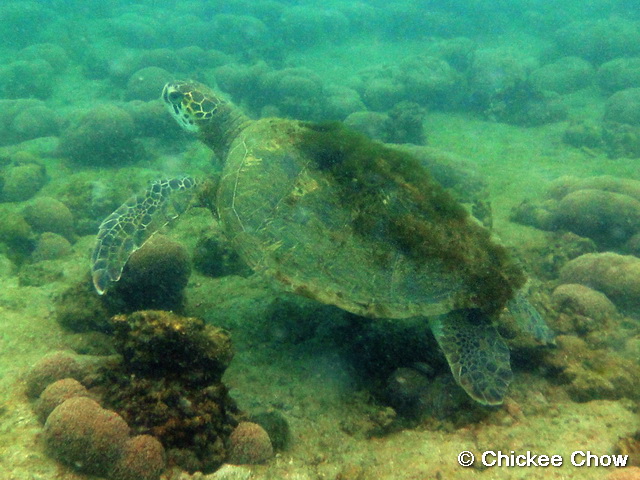Chelonia mydas (Linnaeus, 1758)
Green Turtle 綠海龜
Carapace olive-brown with yellow edge.
Carapace of young
individuals has serrated margin, becomes smoother in older turtle.
Plastron yellow. Head and limbs brown. Limbs modified to flippers.
Weighs about 200kg, one record over 400 kg.
Common name Green Turtle derived from its green fat.
Marine; Nest on beach.
Mature turtles are herbivorous, feed on seagrass and seaweed.
Lays over 100 eggs a time, reported maximum up to 238 in China.
Occasionally seen in southern and eastern part of local waters.
Unusual record: In October 2006,
a juvenile stay in Aberdeen West Typhoon Shelter and left in February 2007.
Sham Wan at Lamma Island has a small population of turtle known to nest regularly.
Only two records of nesting outside Lamma Island:
2000 - Big Wave Bay Beach in Hong Kong Island.
2006 - Tai Long Wan Beach in Sai Kung.
Has a circumglobal
distribution. Occurs throughout the tropical and certain part of subtropical waters.
Nesting occurs in 80 countries worldwide. Believed to inhabit coastal waters of over 140 countries.
Highly migratory with complex movement which is so far less understood;
Possibly extinct in Israel. Regionally extinct in Cayman Islands and Mauritius.
Reintroduced to Bermuda.
Reference:
1.
Wan, P.Y.M.et al. 2007. An Unusual Record: a Juvenile Green Turtle in Aberdeen West Typhoon Shelter. Hong Kong Biodiversity, AFCD. Vol. 15: 16.
2.
Cheung, K.S. et al. 2007. An unusual record of Green Turtle Nesting on Tai Long Wan Beach, Sai Kung East Country Park in 2006. Hong Kong Biodiversity, AFCD. Vol. 14: 13-15
Threatened by intentional harvest of eggs and adults; Fishery bycatch. Degradation of marine environment.
IUCN Redlist: EN (Endangered)
China Redlist: Critically Endangered

